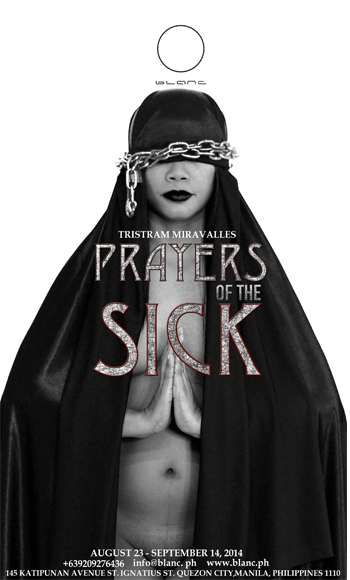PRAYERS OF THE SICK
If I could, I would.
Tristram Miravalles’ statement dangles mercilessly at the tip of his paintbrush. As he wields his brush onto the canvas, it becomes an object far more potent and dangerous than his thoughts. Miravalles’ art becomes his weapon. He opens every war with a silent entreaty and this becomes a provocative collection aptly called Prayers of the Sick.
But Miravalles’ battle cry is far from being religious; not even occult. His visual elements are strikingly raw and appalling but the trance-like images make the viewer apathetic: a metaphor to the hounding realities of Philippine politics where blatant corruption has become a hypnosis that the citizens cannot shake off. Thus, the artist does not mince his words and his imagery. The only way to have peace is by purging out the ills of the society and that can’t be achieved without bloodshed and destruction. The cleansing process takes time but for Miravalles: purity is born out of chaos.
In God’s Butchers, the All-seeing Eye is perched on top of the slaughtering hook. The angels dressed as abattoir workers are about to slit someone’s throat as payment for his crimes against humanity. The workers’ gazes are silent warnings as if saying “we are coming for you next.”
False Wall jumps right at you in the face. The crow head fitted on to a false messianic figure holds up like a warning to all public officials who play god. Those who exploit the poor will be executed on the cross and without redemption.
Miravalles can’t be any more frank on his stand about current issues. The Domino Effect’s social message floats in mid-air like a leaf falling off a tree. This is Janet Lim Napoles’ downfall during the pork barrel scam. Rats symbolic of the opportunistic senators feed on her brain.
Prayers of the Sick is a visual flotilla. The one-man army of Tristram Miravalles has sent an offensive strike against the social unrest and injustice. His process was long and laborious until he finally arrived in reflection. Living in the heart of Bacolod City, the poverty, depression, and despair around him became the fuel of his art.
Every stroke is masterful. The vividness and universality of his theme slices through the core. It leaves an open wound that can only be healed with a promise of remorse. Is there still hope for the society? Will we be cleansed from the sickness? Is there hope for this madness?
Miravalles’ canvas becomes a playground to his existentialist consciousness. He brazenly faces his demons and the absurdities in a collection that defines himself as an individual who rose in the midst of nothingness. In macro, Prayers of the Sick is the society’s reminder that change is a choice and it comes with a price. But only those who can stomach the contemptible can truly have it.
Miravalles definitely can.
WORKS







